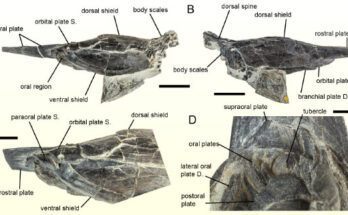There are numerous phrases that could possibly be used to explain WASP-76b — hellish, scorching, turbulent, chaotic, and even violent. This can be a planet outdoors the photo voltaic system that sits so near its star it will get scorching sufficient to vaporize lead. So, as you’ll be able to think about, till now, “superb” wasn’t a type of phrases.
This extra constructive descriptor was added to the checklist fairly just lately, as astronomers have detected hints of one thing known as “glory” within the environment of the ultra-hot Jupiter exoplanet. The glory impact, hinted at in knowledge from the European House Company’s exoplanet-hunting mission Characterizing Exoplanet Satellite tv for pc (CHEOPS), is a rainbow-like association of colourful, concentric rings of sunshine that happen solely beneath peculiar situations.
This impact is commonly seen over our personal planet, in addition to within the environment of our violent neighbor Venus, however that is the primary time scientists have seen it taking place outdoors our cosmic neighborhood; WASP-76b is situated 637 light-years away from us.
On supporting science journalism
When you’re having fun with this text, take into account supporting our award-winning journalism by subscribing. By buying a subscription you might be serving to to make sure the way forward for impactful tales in regards to the discoveries and concepts shaping our world at present.
If the impact is confirmed to be taking place over WASP-76b, it may reveal an ideal deal about this unusual and excessive exoplanet — a world in contrast to something seen in our stellar area.
“There is a cause no glory has been seen earlier than outdoors our Photo voltaic System – it requires very peculiar situations,” Olivier Demangeon, group chief and an astronomer on the Institute of Astrophysics and House Sciences in Portugal, stated in a press release. “First, you want atmospheric particles which are close-to-perfectly spherical, utterly uniform and secure sufficient to be noticed over a very long time. The planet’s close by star must shine immediately at it, with the observer — right here CHEOPS — at simply the proper orientation.”
There’s extra to WASP-76b than molten iron rain
Found in 2013, WASP-76b is situated simply 30 million miles from its dad or mum yellow star, which is round 1.5 instances the mass and 1.75 instances the width of the solar. This distance is only a twelfth of the gap between the solar and Mercury, which is the closest planet to our star.
In consequence, the planet, which is round 1.8 instances the dimensions of Jupiter regardless of solely possessing 92% of the gasoline large’s mass, whips round its star in simply 1.8 Earth days. This proximity additionally causes one aspect of WASP-76b, the “dayside,” to be tidally locked to face its star, WASP-76. The opposite aspect of the planet, the “night time aspect,” perpetually faces out into house.
Because the dayside of WASP-76b is blasted by radiation from its host star, temperatures there soar in extra of 4,350 levels Fahrenheit (2,400 levels Celsius). That is scorching sufficient to vaporize iron. Sturdy and quick winds on WASP-76b then carry this iron vapor to the cooler, night time aspect of the planet, the place it condenses into droplets and falls as iron rain.
The trace of the glory impact over this blistering exoplanet is a exceptional achievement for CHEOPS, which launched in December 2019. It exemplifies the mission’s functionality to detect delicate, never-seen-before phenomena in faraway worlds.
CHEOPS noticed WASP-76b almost two dozen instances over the course of three years as scientists tried to grasp an odd light-asymmetry discovered within the planet’s outer limbs, seen when it crosses, or “transits,” the face of its dad or mum star.
These observations revealed a rise within the gentle coming from WASP-76b’s jap “terminator line,” the divide the place the exoplanet’s nightside turns into its dayside. The group concluded that this sharp change in gentle output is brought on by a powerful, localized, and directionally dependent reflection. They name it the glory impact.
“What’s necessary to remember is the unimaginable scale of what we’re witnessing,” Matthew Standing, an ESA Analysis Fellow finding out exoplanets, stated within the assertion. “WASP-76b is a number of hundred light-years away — an intensely scorching gasoline large planet the place it doubtless rains molten iron.
“Regardless of the chaos, it appears like we’ve detected the potential indicators of a glory. It is an extremely faint sign.”
What does glory imply for WASP-76b?
The glory impact could have a rainbow-like look and colourful striped sample, however it’s really fairly distinct from a literal rainbow.
Rainbows are created when gentle from the solar passes from a medium with one density to a different medium with a unique density, often from air to water. This causes the trail of sunshine to bend, or “refract,” and totally different wavelengths are refracted to totally different levels. Thus, white gentle from the solar is cut up into its constant colours, giving rise to the acquainted ordered and colourful arc of a rainbow.
However, the glory impact occurs when gentle passes via a slim hole. On Earth, this hole could possibly be the house between water droplets in clouds, for example. This causes a unique type of refraction, known as “diffraction,” which occurs when gentle passes an impediment or via an aperture.
As the sunshine waves cut up after which reunite, the place peaks meet troughs, there may be harmful interference. However, the place a peak meets a peak, there may be constructive interference. This leads to darkish and light-weight bands, respectively, and concentric rings of shade.
So what does glory imply for WASP-76b?
The presence of this phenomenon within the environment of the ultra-hot Jupiter signifies the presence of clouds composed of completely spherical water droplets which have both lasted for no less than the three years or clouds which are continuously being replenished.
If the clouds are persistent, this means that the temperature of WASP-76b’s environment, whereas intimidating, have to be secure over time. This can be a fascinating perception hinting at stability round what had lengthy been thought-about an endlessly turbulent world.
The outcomes additionally point out that exoplanet consultants may examine distant worlds for comparable gentle phenomena, together with starlight reflecting off liquid lakes and oceans. That is one thing that could possibly be important in humanity’s ongoing seek for life past the photo voltaic system.
“Additional proof is required to say conclusively that this intriguing ‘further gentle’ is a uncommon glory,” Mission Scientist for ESA’s upcoming Ariel mission, Theresa Lüftinger, stated. “Comply with-up observations from the NIRSPEC instrument onboard the James Webb House Telescope may just do the job. Or ESA’s upcoming Ariel mission may show its presence. We may even discover extra gloriously revealing colours shining from different exoplanets.”
For Demangeon, this potential commentary validates this continued curiosity in investigating the hellish world of Wasp-76b.
“I used to be concerned within the first detection of asymmetrical gentle coming from this bizarre planet—and ever since, I’ve been so curious in regards to the trigger,” the ESA scientist concluded. “It has taken a while to get right here, with moments once I requested myself, ‘Why are you insisting on this? It is perhaps higher to do one thing else together with your time.’
“However when this function appeared out of the information, it was such a particular feeling – a selected satisfaction that doesn’t occur daily.”
The group’s analysis is printed within the journal Astronomy & Astrophysics.
Copyright 2024 House.com, a Future firm. All rights reserved. This materials might not be printed, broadcast, rewritten or redistributed.


